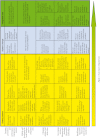Barriers and facilitators to integrating care: experiences from the English Integrated Care Pilots
- PMID: 23593044
- PMCID: PMC3601528
- DOI: 10.5334/ijic.982
Barriers and facilitators to integrating care: experiences from the English Integrated Care Pilots
Abstract
Background: In 2008, the English Department of Health appointed 16 'Integrated Care Pilots' which used a range of approaches to provide better integrated care. We report qualitative analyses from a three-year multi-method evaluation to identify barriers and facilitators to successful integration of care.
Theory and methods: Data were analysed from transcripts of 213 in-depth staff interviews, and from semi-structured questionnaires (the 'Living Document') completed by staff in pilot sites at six points over a two-year period. Emerging findings were therefore built from 'bottom up' and grounded in the data. However, we were then interested in how these findings compared and contrasted with more generic analyses. Therefore after our analyses were complete we then systematically compared and contrasted the findings with the analysis of barriers and facilitators to quality improvement identified in a systematic review by Kaplan et al. (2010) and the analysis of more micro-level shapers of behaviour found in Normalisation Process Theory (May et al. 2007). Neither of these approaches claims to be full blown theories but both claim to provide mid-range theoretical arguments which may be used to structure existing data and which can be undercut or reinforced by new data.
Results and discussion: Many barriers and facilitators to integrating care are those of any large-scale organisational change. These include issues relating to leadership, organisational culture, information technology, physician involvement, and availability of resources. However, activities which appear particularly important for delivering integrated care include personal relationships between leaders in different organisations, the scale of planned activities, governance and finance arrangements, support for staff in new roles, and organisational and staff stability. We illustrate our analyses with a 'routemap' which identifies questions that providers may wish to consider when planning interventions to improve the integration of care.
Keywords: England; barriers; facilitators; integrated care.
Similar articles
-
The Effectiveness of Integrated Care Pathways for Adults and Children in Health Care Settings: A Systematic Review.JBI Libr Syst Rev. 2009;7(3):80-129. doi: 10.11124/01938924-200907030-00001. JBI Libr Syst Rev. 2009. PMID: 27820426
-
(Dis)Integrated Care? Lessons from East London.Int J Integr Care. 2020 Oct 19;20(4):2. doi: 10.5334/ijic.5432. Int J Integr Care. 2020. PMID: 33177965 Free PMC article.
-
Beyond the black stump: rapid reviews of health research issues affecting regional, rural and remote Australia.Med J Aust. 2020 Dec;213 Suppl 11:S3-S32.e1. doi: 10.5694/mja2.50881. Med J Aust. 2020. PMID: 33314144
-
Rapid evaluation of the Special Measures for Quality and challenged provider regimes: a mixed-methods study.Health Soc Care Deliv Res. 2023 Oct;11(19):1-139. doi: 10.3310/GQQV3512. Health Soc Care Deliv Res. 2023. PMID: 37921786 Review.
-
Reducing unplanned hospital admissions from care homes: a systematic review.Health Soc Care Deliv Res. 2023 Oct;11(18):1-130. doi: 10.3310/KLPW6338. Health Soc Care Deliv Res. 2023. PMID: 37916580
Cited by
-
The development of an integrated neighborhood approach for health promotion and prevention: a qualitative exploration of stakeholders' views.Health Res Policy Syst. 2023 Nov 28;21(1):125. doi: 10.1186/s12961-023-01077-4. Health Res Policy Syst. 2023. PMID: 38017576 Free PMC article.
-
Using Normalisation Process Theory (NPT) to develop an intervention to improve referral and uptake rates for self-management education for patients with type 2 diabetes in UK primary care.BMC Health Serv Res. 2022 Sep 27;22(1):1206. doi: 10.1186/s12913-022-08553-7. BMC Health Serv Res. 2022. PMID: 36167564 Free PMC article. Review.
-
Multiple Perspectives Analysis of the Implementation of an Integrated Care Model for Older Adults in Quebec.Int J Integr Care. 2019 Nov 14;19(4):6. doi: 10.5334/ijic.4634. Int J Integr Care. 2019. PMID: 31798357 Free PMC article.
-
How Different Quality Paradigms Undermine a Shared Value Base for Integrated Care: The Need for Collective Reflexivity.Int J Integr Care. 2022 Jan 21;22(1):5. doi: 10.5334/ijic.5935. eCollection 2022 Jan-Mar. Int J Integr Care. 2022. PMID: 35087354 Free PMC article.
-
Perceptive Dialogue for Linking Stakeholders and Units During Care Transitions - A Qualitative Study of People with Stroke, Significant Others and Healthcare Professionals in Sweden.Int J Integr Care. 2020 Mar 25;20(1):11. doi: 10.5334/ijic.4689. Int J Integr Care. 2020. PMID: 32256255 Free PMC article.
References
-
- Yach D, Hawkes C, Gould CL, Hofman KJ. The global burden of chronic diseases. The Journal of the American Medical Association. 2004;291(21):2616–22. - PubMed
-
- Glasby J, Dickinson H, Peck E. Partnership working in health and social care. Health and Social Care in the Community. 2006;14(5):373–4. - PubMed
-
- Bodenheimer T, Wagner EH, Grumbach K. Improving primary care for patients with chronic illness. The Journal of the American Medical Association. 2002;288(14):1775–9. - PubMed
-
- Bodenheimer T, Wagner EH, Grumbach K. Improving primary care for patients with chronic illness: the chronic care model, Part 2. The Journal of the American Medical Association. 2002;288(15):1909–14. - PubMed
-
- Nolte E, McKee M. Caring for people with chronic conditions: a health system perspective. Maidenhead, UK: Open University Press/McGraw Hill Education; 2008.
LinkOut - more resources
Full Text Sources


